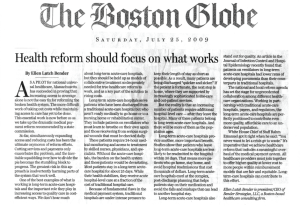Health reform should focus on what works
 AS A PILOT for national universal health care, Massachusetts has succeeded in proving that increasing access to coverage alone is not the easy fix for reforming the broken health system. The more difficult work of taking out costs while maintaining access to care has yet to be done.
AS A PILOT for national universal health care, Massachusetts has succeeded in proving that increasing access to coverage alone is not the easy fix for reforming the broken health system. The more difficult work of taking out costs while maintaining access to care has yet to be done.
This essential work is now before us as we take up the dramatic medical payment reform recommended by a state commission.
So far, simultaneously expanding access and reducing costs has been the ultimate oxymoron of reform efforts. Cutting services and payments only exacerbates the problem, and the inevitable squabbling over how to divide the pie becomes the stumbling block to progress. The greatest risk in this approach is inadvertently harming parts of the system that work well.
One of the best examples of what is working is long-term acute-care hospitals and the important part they play in increasing access to quality care in cost-efficient ways. We don’t hear much about long-term acute-care hospitals, but they should be held up as models of collaborative treatment so desperately needed for true health care reform to work, and as a key part of the solution to rising costs.
Long-term acute-care hospitals serve patients who have been discharged from a traditional acute-care hospital but who aren’t ready medically to go home or to a nursing home or rehabilitation center. They include patients on ventilators who must learn to breath on their own again and those recovering from serious surgical wounds that must be checked daily.
These patients require 24-hour medical monitoring and access to treatment by skilled nurses, physicians, and specialists. Without the acute-care hospitals, the burden on the health system and these patients would be devastating. Most patients stay in a long-term acute-care hospital for about 25 days. While their health stabilizes, they receive acute hospital-level care at a fraction of the cost of traditional hospital care.
Because of fundamental flaws in the medical payment system, traditional hospitals are under intense pressure to keep their length of stay as short as possible. As a result, many patients are being discharged “quicker and sicker”. If the patient is fortunate, the next stop is home, where they are supported by increasingly sophisticated home-care and out-patient services.
But the reality is that an increasing number of patients require additional hospital-level care – after they leave the hospital. Many of these patients belong in long-term acute-care hospitals. And there will be more of them as the population ages.
Long-term acute-care hospitals provide another, more important benefit. Studies show that patients who leave long-term acute-care hospitals are less likely to be readmitted to the hospital within 30 days. That means more patients who go home, stay home, and avoid hospital readmissions that cost thousands of dollars. Long-term acute-care hospitals excel at the complex, post-discharge planning that helps patients stay on their medication and avoid the falls and mishaps that can lead to another hospital stay.
Long-term acute-care hospitals also stand out for quality. An article in the Journal of Infection Control and Hospital Epidemiology recently found that patients on ventilators in long-term acute-care hospitals had lower rates of developing pneumonia than their counterparts in traditional hospitals.
The national & local reform agenda has set the stage for unprecedented collaboration among different health-care organizations. Working in partnership with traditional acute-care hospitals, payers, and regulators, the long-term acute-care hospitals are perfectly positioned to contribute even more quality, affordable care to an undeserved population.
White House Chief of Staff Rahm Emanuel got it right when he said: “You never want to let a crisis go to waste.” It’s imperative that we achieve health care reform that includes a meaningful overhaul of the medical payment system. All health care providers must join together to offer higher quality at lower cost to more people within reimbursement models that are fair and equitable. Long-term-care hospitals can contribute to this effort.

